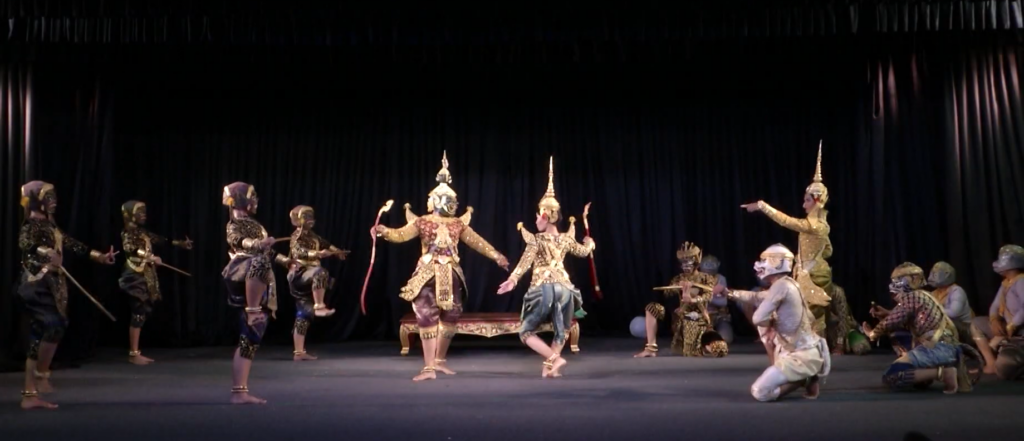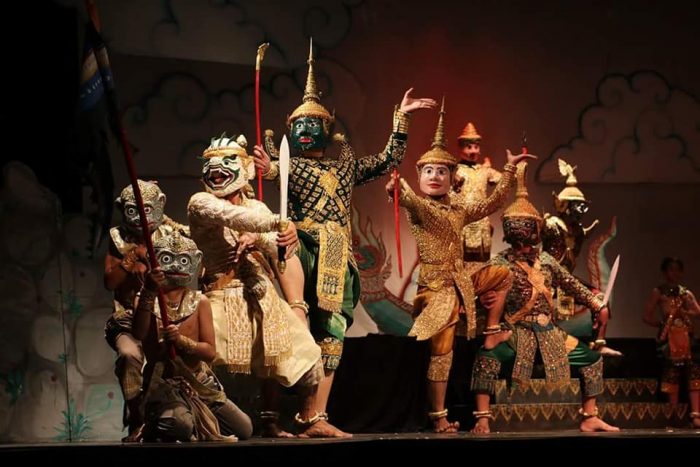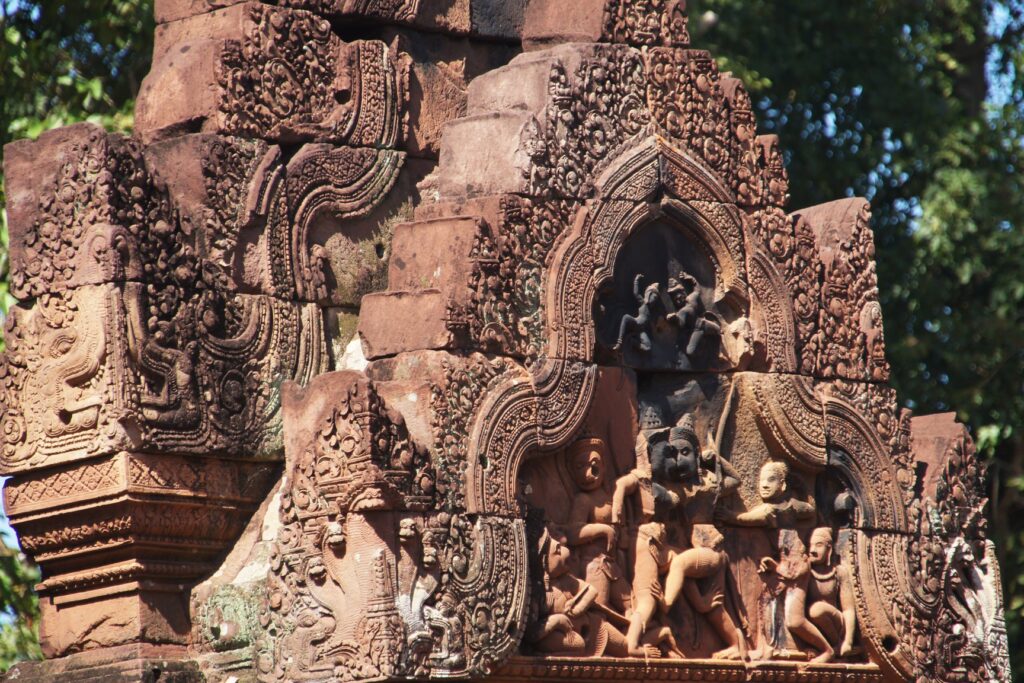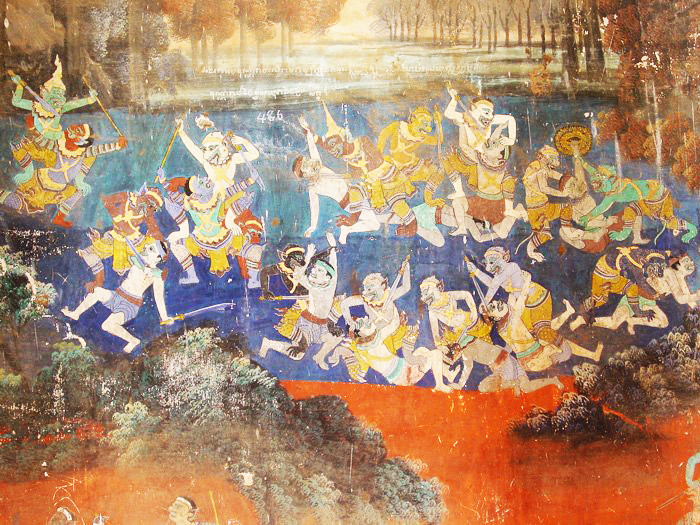ជាការពិតណាស់ដែលគេចាត់ទុករឿងរាមកេរ្តិ៍ ជារឿងមួយដែលមានប្រជាប្រិយភាពខ្លាំងនៅក្នុងចំណោមរឿងធំៗឯទៀតក្នុងពិភពលោក។ ប្រជាប្រិយភាពនេះ គឺមានឆ្លុះបង្ហាញដូចជា នៅក្នុងការយកទៅប្រើប្រាស់ដោយច្នៃប្រឌិតអន្លើខ្លះនៅក្នុងរឿង ទៅតាមតំបន់និងប្រទេសដែលធ្វើឥណ្ឌាភាវូបនីយកម្ម។ នៅប្រទេសឥណ្ឌា ដែលរឿងរាមាយណមានដើមកំណើត Narayan បានអះអាងថា ក្មេងៗឥណ្ឌាទាំងអស់តែងតែបានស្តាប់មាតាបិតានិទានរឿងនេះឱ្យស្តាប់នៅពេលមុនចូលគេង។ អ្នកខ្លះទៀត រៀនសូត្រអំពីរឿងនេះ ដើម្បីជាបទពិសោធន៍សាសនា ដោយអានល្បះខ្លះរាល់ថ្ងៃ ក៏ដូចជាមើលហើយមើលទៀតជាច្រើនដងនៅក្នុងជីវិតរបស់គេ។
សិល្បករសិល្បការិនីខ្មែរ យករឿងរាមកេរ្តិ៍ ជាប្រធានបទធំមួយដើម្បីបង្កើតនិងអភិវឌ្ឍសិល្បៈរូបីនិងអរូបី រួមមាន ចម្លាក់ សូនរូប គំនូរលើក្រដាសឬជញ្ជាំង ការបោះពុម្ពលើក្រដាសឬក្រណាត់ ល្ខោនក្បាច់បុរាណ ល្ខោនខោល ល្ខោនស្បែក ច្រៀងចាប៉ី និទានរឿង និងហោរាសាស្ត្រ។ នៅក្នុងអត្ថបទដ៏ខ្លីនេះ ខ្ញុំសូមនិយាយតែអំពីទម្រង់មួយចំនួនតូចដែលពាក់ព័ន្ធនឹងរឿងរាមកេរ្តិ៍តែប៉ុណ្ណោះ។

នៅក្នុងល្ខោនក្បាច់បុរាណខ្មែរ ដែលជាទម្រង់ស្រីសុទ្ធ រឿងរាមកេរ្តិ៍ ជាប្រធានបទនិងមូលដ្ឋានសំខាន់ក្នុងការបង្កើតនិងអភិវឌ្ឍសាច់រឿង ដូចដែលយើងឃើញមាននៅក្នុងឈុតព្រះរាមដើរទេស ដេញប្រើសមាស រាពណ៍ចាប់យកនាងសីតា សុវណ្ណមច្ឆា ព្រះរាមត្រួតពល ចម្បាំងរវាងព្រះរាមនិងរាពណ៍ រាមលក្ខណ៍ជបលក្ខណ៍ ព្រះរាមចូលកោដ្ឋបញ្ឆោតនាងសីតា ជាដើម។
នៅក្នុងល្ខោនខោល ឬ ល្ខោនបិទមុខខ្មែរ ដែលជាទម្រង់ល្ខោនរាំដោយប្រុសៗសុទ្ធ គេប្រើតែរឿងរាមកេរ្តិ៍មួយតែប៉ុណ្ណោះ ទោះបីជាគេមិនដែលបានសម្តែងសាច់រឿងពីដើមដល់ចប់ក៏ដោយ។ គេជ្រើសរើសយកតែឈុតខ្លះមកសម្តែង ដូចជាឈុត ព្រះរាមចងថ្នល់ កុម្ភការណ៍ទប់ទឹក វិរុលចម្បាំង ចម្បាំងឥន្ទជិត ចម្បាំងពេលយប់ និងចម្បាំងវៃយរាពណ៍។

ចំណែកឯល្ខោនស្រមោលស្បែកធំខ្មែរ ក៏ប្រើតែរឿងរាមកេរ្តិ៍មួយប៉ុណ្ណោះដែរ។ ក្រុមល្ខោនស្បែកធំ សាលាកន្សែង ខេត្តសៀមរាប នៅតែបន្តសម្តែងរឿងរាមកេរ្តិ៍ប្រាំពីរឈុតមានដូចជា ព្រះរាមចងថ្នល់ឬចម្បាំងឥន្ទជិត បញ្ជកាយបណ្តែតទឹក សរព័ន្ធ ចម្បាំងកំប៉ាន់ សរព្រហ្មាស្ត្រ សុក្កចា និងឥន្ទជិតផ្តាំមឿង។
ដោយឡែក នៅលើជញ្ជាំងប្រាសាទបុរាណខ្មែរ រួមទាំងប្រាសាទអង្គរវត្តជាដើម រឿងរាមកេរ្តិ៍ត្រូវបានបុព្វបុរសខ្មែរឆ្លាក់ជាប់នៅលើជញ្ជាំងប្រាសាទ ជាតឹកតាងបញ្ជាក់ច្បាស់អំពីសារៈសំខាន់នៃរឿងនេះ។ ប្រាសាទនានាមួយចំនួនទៀតក៏មានចម្លាក់រឿងរាមកេរ្តិ៍ដែរ គឺប្រាសាទ កោះកេរ(ស.វ. ទី១០) បន្ទាយស្រី(ស.វ. ទី១០) បាពួន(ស.វ. ទី១១) ភ្នំរូង(នាប្រទេសថៃបច្ចុប្បន្ន) (ស.វ. ទី១១) ភីម័យ (នាប្រទេសថៃបច្ចុប្បន្ន)(ស.វ. ទី១១) អង្គរវត្ត (ស.វ. ទី១២)បន្ទាយសម្រែ (ស.វ. ទី១២) និងធម្មានន្ទ (ស.វ. ទី១២)។

ចំណែកឯគំនូរខ្មែរវិញ យើងឃើញច្បាស់នូវប្រធានបទរឿងរាមកេរ្តិ៍ ដូចជានៅតាមថែវនៃព្រះវិហារវត្តខ្មែររូមមាន វត្តរាជបូព៌ ខេត្តសៀមរាប និង វត្តចតុទិស ស្រុកឧត្តុង្គ ខេត្តកំពង់ស្ពឺ។ នៅឆ្នាំ១៩៣០ នៅក្រោមព្រះរាជចក្ខុវិស័យដ៏ថ្លៃថ្លារបស់ព្រះបាទសម្តេចព្រះនរោត្តម គំនូរពណ៌១៧៧ផ្ទាំងបានគូរនៅលើជញ្ជាំងកម្ពស់២,៥ ម៉ែត្រ និងប្រវែង ៦១៦ ម៉ែត្រ នៃព្រះវិហារព្រះកែវមរកត ព្រះបរមរាជវាំងទីក្រុងភ្នំពេញ។ ទោះបីប្រធានបទរបស់គំនូរខ្មែរមានពាក់ព័ន្ធនឹងជីវិត ធម្មជាតិ កសិកម្ម ប្រពៃណី ទំនៀមទម្លាប់ ព្រះពុទ្ធសាសនា និងទេវកថាក៏ដោយ វិចិត្រករនិងជាងគំនូរខ្មែរ ក៏ផ្តោតប្រធានបទរបស់គេទៅលើសាច់រឿងនិងតួអង្គនៅក្នុងរឿងរាមកេរ្តិ៍ដែរ។

លើសពីនេះទៅទៀត រឿងរាមកេរ្តិ៍ មានឥទ្ធិពលទៅលើជីវិតរបស់ខ្មែរខ្លះ ដែលគាត់មានជំនឿទៅលើហោរាសាស្ត្រ។ ក្នុងករណីនេះ គេអាចរកគ្រូហ្មឱ្យទស្សទាយជោគវាសនាអនាគតនៃជីវិតរបស់គេ ដោយហូតយកសន្លឹកបៀរដែលមានរូបតួអង្គក្នុងរឿងរាមកេរ្តិ៍។ ប្រសិនបើគេដកយកបានសន្លឹកបៀរដែលមានរូបព្រះរាមឬសីតា គេនឹងទទួលបាននូវជោគវាសនាល្អ។ ផ្ទុយទៅវិញ បើគេដកហូតយកបានសន្លឹករូបក្រុងរាពណ៍ ឬ ក្រុងខរ គេនឹងទទួលបាននូវភាពឧបទ្រពចង្រៃ គ្រោះថ្នាក់មហន្តរាយផ្សេងៗ ដែលនឹងធ្លាក់ទៅលើរូបគេ។
នាអតីតកាល ការនិទានរឿង ជាទម្រង់សិល្បៈមួយដែលមានប្រជាប្រិយភាពណាស់នៅក្នុងសង្គមខ្មែរជាពិសេសនៅតាមទីជនបទស្រុកស្រែចម្ការ។ ខ្មែរយើងធ្លាប់មានបទពិសោធន៍ ដោយធ្លាប់បានឮឪពុកម្តាយឬចាស់ៗនិទានរឿឱ្យស្តាប់នៅពេលបាយ ឬពេលយប់មុននឹងចូលដេក។ រឿងរាមកេរ្តិ៍ ក៏ត្រូវបានគេយកមកនិទាន ជាពិសេសដោយអ្នកនិទានរឿងដ៏ល្បីរបស់ខ្មែរ គឺលោក តា ចក់ និងលោកតា គ្រុឌ ដែលមានឈ្មោះល្បីណាស់នៅមុនឆ្នាំ១៩៧៥។ សរុបសេចក្តីមក យើងឃើញថា រឿងរាមកេរ្តិ៍ មានប្រភពនិងដើមកំណើតនៅប្រទេសឥណ្ឌា ប៉ុន្តែខ្មែរយើងមានទេពកោសល្យច្នៃប្រឌិតកែខៃធ្វើខេមរភាវូបនីយកម្មឱ្យរឿងរាមកេរ្តិ៍ឥណ្ឌាក្លាយមកជារឿងរាមកេរ្តិ៍ខ្មែរ លាតត្រដាងបកស្រាយបង្ហាញអំពីសង្គម ជីវិត និងមនោសញ្ចេតនាខ្មែរ ដែលសិល្បករសិល្បការិនីខ្មែរយកជាគំនិតដើម្បីច្នៃបន្តបង្កើតជាស្នាដៃសិល្បៈរូបីនិងអរូបី ក៏ដូចជាអក្សរសិល្ប៍ ដូចដែលបានរៀបរាប់មកខាងលើ៕
—————————————
REAMKER IN KHMER ARTS
There is no doubt that the Reamker or Ramayana is one of the most popular and exciting stories in the world. Its popularity is attested by the adoption and adaptation to regional and local stories, particularly, in the Indianized states of Southeast Asia. In India, where the story originated, Narayan asserted that every child is told the story at bedtime. Some study it as a part of religious experience, going over certain stanzas each day, reading and rereading the book several times in a lifetime (1972: xi).
The Khmer Reamker has served as the main theme for the development of many Khmer arts, including sculpture, painting, drawing, fresco, temple murals, canvases, scrolls, stampings, children books, weaving and silk-screening, court dance drama, masked play, shadow play, epic singing, story-telling, and astrology. For the interest of this article, I shall allude to only a couple of traditions and forms.
In Khmer court dance drama, a female dance form, the Reamker serves as the main theme for its development of story and plots, whose excerpts include The Banishment of Preah Ream, Preah Ream’s Exile, The Chase of the Golden Stag, The Abduction of Sita, Suvann Machha, Preah Ream Reviewing His Troops, The Battle of Reap also known as The Battle of Lanka, Ream Leak Chup Leak also known as The Reconciliation of Preah Ream with His Children, Sita and the Test of Fire or Fire Ordeal, and Preah Ream and the Test of Funeral Urn.
In Khmer masked play, known locally as lkhaon khaol, a male dance-theater form, the Reamker is the sole story used as its story-base, although never before has the complete story been performed. Only a few episodes are chosen and adapted for the play. The most popular ones for this theatrical form are Preah Ream Tying the Road (Preah Ream Chang Thnall), The Water Barrage of Kumphakar (Kumphakar Tup Toeuk) also known as The Battle of Kumphakar (Chambaing Kumphakar), Virul Chambaing, The Battle of Intrachitt (Chambaing Intrachitt), Battle at Night (Chambaing Pel Yup), and The Battle of Vey Reap (Chambaing Vey Reap).
The surviving shadow play troupe in Sala Kansaeng, Siem Reap still occasionally puts together the seven-night episodes of Reamker. They are The Battle of Intrachitt and Preah Leak (Chambaing Intrachitt noeung Preah Leak) also known as Tying the Road (Chang Thnall), Banhakay (Banjakaya) also known as The Floating Maiden (Banhakay Andaet Toeuk), Tangling or Twisting Arrow (Sar Poan), The Battle of Kampann and Hanuman (Chambaing Kampann noeung Hanuman), Brahma Arrow (Sar Prummeas), Sokkacha, and Lament of Intrachitt (Intrachitt Phdaim Moeurng).
On Khmer ancient stone temples, including Angkor Vatt, the Reamker is prominently carved, attesting to the importance of the story. They are Kah Ke Temple (10th Century), Banteay Srey Temple (10th Century), Ba Puon Temple (11th Century), Phnom Roung Temple (in Thailand) (11th Century), Phimai Temple (in Thailand) (11th Century), Angkor Vatt Temple (12th Century), Banteay Samrae Temple (12th Century), and Thormanun Temple (12th Century).
The subject of Reamker is steadily prominent in Khmer painting. Along the walls of the monastic shrine-halls, including Vatt Bau (Siem Reap) and Vatt Chaktotih (Uddong, Kampung Spoeu), the Reamker was ornately painted. In 1903, under the royal vision, initiation, and patronage of King Norodom, on the walls of the Preah Vihear Preah Keo Morakod (also known as the Silver Pagoda) of the Royal Palace in Phnom Penh, 177 fresco scenes of Reamker were ornately and colorfully painted into panels of 2.5 meters high along the pagoda walls of 616 meters long. While the subject matters for Khmer painting include nature, agriculture, Buddhism, and mythology, the themes and ideas drawn from the Reamker are used widely by Khmer painters on canvas and paper, including scenes and characters from the story.
The importance of Reamker in Khmer life cannot be understated. Some Khmer still believe and practice astrology, even today. They may seek help from astrologers to foresee their future. For instance, should their cards be drawn on Rama or Sita, then, they would have good luck. On the contrary, should their cards be drawn on Ravana or Khara, then, it is an omen for their future will be cloudy, befalling upon bad luck and misfortune.
Here finally, story-telling was once a popular form of entertainment and oral tradition in Cambodia. It was often heard stories told by parents or grandparents at meal-times or bed-times. During the cold season, bond fires were made where adults and children alike gathered around them to warm up their bodies while listening to the elderly who told different stories, entertaining and creating a warm and intimate atmosphere for the evening until the times they needed to retreat to bed. The Reamker was adapted by story-tellers, namely, Ta Chakk and Ta Krud, the versions that were known as Reamker Ta Chakk and Reamker Ta Krud respectively. They were very popular during the pre-1975 period. The Khmer Reamker, indeed, has its deep roots in the Indian tradition, but the Khmer have Khmerized the Ramayana to suit their taste and temperament, responding to their national identity and character. The Khmer Reamker is an enormous moral tale that epitomizes the wealth of Khmer literature and arts, equally reflecting the Khmer thinking and temperament as well as Khmer social justice. As a Buddhist country, in Khmer interpretation, Preah Ream or Prince Rama is often portrayed as a Bodhisatva himself, particularly, from the view point of a moral character with supreme power in talent, renunciation, intelligence, energy, long-suffering, veracity, determination, love of justice, and equanimity, which the Bodhisatva must accomplish to attain the Buddha state.
អត្ថបទដើម៖ បណ្ឌិត សំ សំអាង






